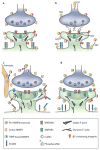Synaptic circuit remodelling by matrix metalloproteinases in health and disease
- PMID: 23047773
- PMCID: PMC4900464
- DOI: 10.1038/nrn3320
Synaptic circuit remodelling by matrix metalloproteinases in health and disease
Abstract
Matrix metalloproteinases (MMPs) are extracellularly acting enzymes that have long been known to have deleterious roles in brain injury and disease. In particular, widespread and protracted MMP activity can contribute to neuronal loss and synaptic dysfunction. However, recent studies show that rapid and focal MMP-mediated proteolysis proactively drives synaptic structural and functional remodelling that is crucial for ongoing cognitive processes. Deficits in synaptic remodelling are associated with psychiatric and neurological disorders, and aberrant MMP expression or function may contribute to the molecular mechanisms underlying these deficits. This Review explores the paradigm shift in our understanding of the contribution of MMPs to normal and abnormal synaptic plasticity and function.
Figures



References
-
- Butler GS, Overall CM. Updated biological roles for matrix metalloproteinases and new “intracellular” substrates revealed by degradomics. Biochemistry. 2009;48:10830–45. - PubMed
-
- McFarlane S. Metalloproteases: carving out a role in axon guidance. Neuron. 2003;37:559–62. - PubMed
-
- Rivera S, Khrestchatisky M, Kaczmarek L, Rosenberg GA, Jaworski DM. Metzincin proteases and their inhibitors: foes or friends in nervous system physiology? J Neurosci. 30:15337–57. This is an up-to-date review on MMPs, ADAMs and ADAMs-TSs in nervous system function and pathophysiology. - PMC - PubMed
Publication types
MeSH terms
Substances
Grants and funding
LinkOut - more resources
Full Text Sources
Medical

